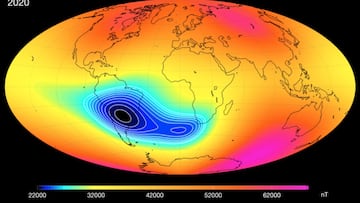NASA monitors Earth’s mysterious magnetic field anomaly: a “pothole in space”
The South Atlantic Anomaly causes technical problems for satellites and spacecraft and calls into question the uniformity of the Earth’s magnetic field.

For years, NASA has been studying a growing anomaly in Earth’s magnetic field that scientists liken to a “dent” or “pothole in space.” It is a giant region of lower magnetic intensity, which extends between South America and southwestern Africa.
This phenomenon, dubbed the South Atlantic Anomaly (SAA), is of concern to researchers since it poses challenges for satellites and spacecraft and raises questions about the uniformity of our planet’s magnetic shield.
A weak spot in Earth’s magnetic field
NASA researchers have been tracking this strange phenomenon as it is of significant concern for scientists because satellites and spacecraft passing through it become particularly vulnerable to charged solar particles.
According to Science Alert, the anomaly exposes orbital technologies, including the International Space Station, to potential malfunctions. High-energy protons from the Sun can penetrate this weakened region, potentially causing short circuits or operational failures in the sensitive electronics aboard these crafts.
A dynamic and expanding phenomenon
What makes the SAA even more perplexing is its dynamic nature. Recent observations reveal that it’s not a static feature—it’s expanding and appears to be splitting into two distinct regions. This evolution complicates efforts to study and predict its behavior, making it an area of intense scientific focus.
What is causing the South Atlantic Anomaly?
Earth’s magnetic field originates from the movement of molten iron in the planet’s outer core, a process generating electric currents that create the field. However, this magnetic shield is far from uniform. “The magnetic field is actually a superposition of fields from many current sources,” explained NASA geophysicist Terry Sabaka in 2020.
One leading hypothesis attributes the anomaly to a massive underground feature called the African Large Low Shear Velocity Province. This dense rock formation, located about 1,800 miles (2,900 kilometers) beneath Africa, may be disrupting the magnetic field’s generation. Additionally, the planet’s tilted magnetic axis could be exacerbating the phenomenon.
Why it matters
While the SAA does not directly impact life on Earth, its implications for orbital technologies and space missions are significant. As the anomaly continues to evolve, scientists remain focused on understanding its causes and mitigating its risks to critical space infrastructure.
Article originally written in Spanish, translated with the assistance of AI and edited by Greg Heilman.
Related stories
Get your game on! Whether you’re into NFL touchdowns, NBA buzzer-beaters, world-class soccer goals, or MLB home runs, our app has it all.
Dive into live coverage, expert insights, breaking news, exclusive videos, and more – plus, stay updated on the latest in current affairs and entertainment. Download now for all-access coverage, right at your fingertips – anytime, anywhere.